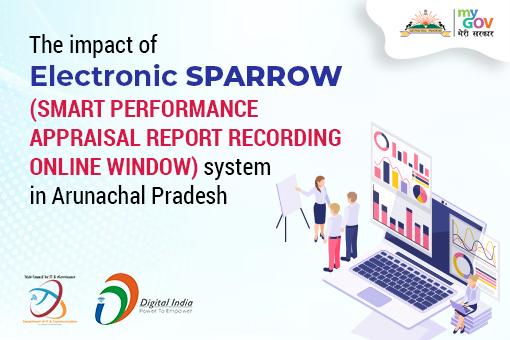SPARROW has been introduced as an online performance appraisal system for all government functionaries in Arunachal Pradesh. This system aims to bring transparency and efficiency to the performance appraisal process. The primary department responsible for implementing SPARROW is the Administrative Reforms Department.
Currently, SPARROW is being used for all APCS and AP Secretariat staff where some have enrolled and started to file their appraisal online, as well as other government departments are expected to come on board soon. This online system promises a speedy and transparent appraisal process for all government officials.
As of now, 51 departments have submitted their APAR forms, while 13 departments were yet to do so. Also, reminder letters have been issued to 13 departments as well as the National Informatics Center (NIC) has been instructed to integrate the APAR form into the SPARROW portal.
The SPARROW project is a positive and welcome step towards digitisation and efficiency in the administrative sector of Arunachal Pradesh, aimed to bring transparency and expedite the annual performance appraisal process.
Calling citizens to share their views on SPARROW and ways to witness its seamless integration into all government departments.













Sakthivel 1 year 4 months ago
World Sparrow Day is an initiative of the Nature Forever Society and was first observed in 2010. Today, there is plenty of international support to mark the occasion. Reminisces Dilawar, “We came up with the idea of celebrating World Sparrow Day during an informal discussion over tea in our office. We felt there was a potential
Sakthivel 1 year 4 months ago
Sparrows also play a vital role in the food chain. They feed on small insects and worms such as caterpillars, beetles and aphids. Some of these creatures destroy plants and the sparrow helps keeps their numbers in check. In turn, they also serve as prey for larger birds like hawks and snakes.
Sakthivel 1 year 4 months ago
Like every living creature, sparrows are important for preserving our natural ecosystem. Back in 1960, following China’s Great Sparrow Campaign, China suffered its worst famine. The Communists hadn’t realised that sparrows don’t just eat crops, but also insects. Following their elimination, China’s locust population soared and destroyed crops. Grain production in most rural areas collapsed, triggering a famine. Millions of people starved to death.
Sakthivel 1 year 4 months ago
Conservationist Mohammed Dilawar, Founder & President - Nature Forever Society adds that contemporary urban living habits are limiting the sparrow’s access to food. “Earlier, our doors and windows would remain open all day while people sat and cleaned food grains at home. Shopkeepers would also keep grains for sale in open sacks, quite unlike packed grains sold in shops and closed supermarkets today. The birds have lost the luxury of flying indoors for a quick bite.”
Sakthivel 1 year 4 months ago
Access to food is another problem for the House sparrow which thrives on high-protein diets comprising insects, grains, seeds and food crumbs left by humans. Modern agriculture is a huge culprit. The rampant use of insecticides and pesticides has resulted in the decline in the availability of insect-feed needed by new-born sparrows.
Sakthivel 1 year 4 months ago
Modern buildings, often made of glass, or inaccessible houses that are mostly netted, are devoid of cavities that provide suitable nesting space for the sparrow. Also, the concrete jungles we live in lack essential green spaces and native trees required for nesting, feeding, breeding and roosting (i.e. raising offspring).
Sakthivel 1 year 4 months ago
While exact population estimates are unavailable, some reports suggest a decline of 80 per cent in India’s sparrow population. One of the key reasons for this decline is our changing urban lifestyle, which causes habitat destruction. Sparrows prefer to live in crevices and holes of man-made structures rather than naturally occurring nesting sites in forests or woodlands. Modern buildings, often made of glass, or
Sakthivel 1 year 4 months ago
Recent studies have revealed that the evolutionary process of natural selection may have favoured genetic changes that altered their skull shape and allowed them to digest starch like other domesticated animals such as dogs.
Sakthivel 1 year 4 months ago
This, even as evidence emerges that in its 10,000 years of documented existence, the House sparrow (Passer domesticus)—the most commonly found variety in India—has evolved in surprising ways to match human evolutionary patterns. Not only does it live close to human settlements, its genes have also evolved to enable its body to eat and digest human-cultivated food. Recent studies have revealed that the evolutionary process of natural selection may have favoured genetic changes that altered their
Sakthivel 1 year 4 months ago
There are 24 known varieties of sparrows in the world. Over the years, their population has reduced drastically. This, even as evidence emerges that in its 10,000 years of documented existence, the House sparrow (Passer domesticus)—the most commonly found variety in India—has evolved in surprising ways to match